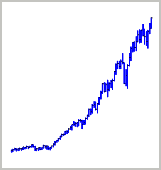 Menu
Menu
 Menu
Menu

Since 1990, when Harry Markowitz won a Nobel Prize for “Modern Portfolio Theory” (MPT), it has become the standard for portfolio construction. MPT is the force behind today’s emphasis on diversification.
If you make a practice of holding individual stocks with the hope of hitting a home run, but in insufficient numbers to adequately diversify, MPT states that you will not be compensated over the long term for the extra risk you are taking. Well-diversified portfolios produce the least risk for any given level of gain. The expected return and degree of risk is defined by the types and relationship of the assets held in the portfolio. There is little to be gained from “stock-picking”, other than additional risk. Asset selection and composition are all important.
Because LFM&P’s investment approach is client goal-centered, a primary emphasis is reducing risk and volatility. Reducing variability and increasing predictability of results is a primary objective, if you are planning to withdraw funds for a financial goal, like college expenses or retirement at a particular time.
LFM&P’s MarketAwareSM strategy seeks to manage your investment risk by adjusting your asset allocation. Reducing your portfolio risk during times when stock prices are over-valued or price trends are falling, and increasing your equity exposure when market risk is low, can help you to maintain a more consistent overall risk exposure.
At first glance, the often-used “unaware” fixed asset allocation Buy-and-Hold approach seems to provide a constant risk profile. In reality, however, underlying market risk is passed through, so your overall risk level is constantly and invisibly changing with market conditions. Adjusting your portfolio to counterbalance changing market risk can improve risk-adjusted returns, which is the best measurement of effective portfolio management. Additionally, awareness of leading asset classes provides the capacity to emphasize investments that are performing well in the current environment.
MarketAwareSM does not attempt to produce greater gains than the market is capable of providing, because MPT says that such gains can only be achieved by taking more risk (i.e. buying with borrowed funds or otherwise adding leverage to the portfolio). You cannot generate a long-term diversified return that is greater than that of the underlying asset class without increasing risk. Temporary outsized gains, produced by non-diversification, that are followed by outsized losses are of no value.
MarketAwareSM focuses on managing risk. Using a client’s risk tolerance as a starting point, the MarketAwareSM strategy increases risk exposure (and therefore the potential for gains) in a low risk environment and reduces it in a high-risk environment. This, coupled with selecting appropriate asset classes, leads to the overall goal of producing higher risk-adjusted returns, which is the objective of serious investment management.
David Linnard, President of LFM&P and portfolio manager, developed the MarketAwareSM strategy for his own benefit and personal use. Because he never wanted to take more than necessary risk, the ubiquitous passive Buy-and-Hold fixed allocation strategy was never a comfortable prospect. He recognized the necessity of investing to provide for his long-term well-being, but never accepted the idea that sustaining bear market-sized losses was necessary. It was also disturbing that in many cases, retirees and others who use investment returns for living expenses could be hurt by having to withdraw funds when the value of the portfolio has been beaten down during a bear market. This creates a situation that is just the opposite of the well-known dollar-cost averaging strategy, since more shares are sold at lower prices, lowering the average sale price per share. This has the counterproductive effect of requiring a greater percentage of the portfolio be sold to produce withdrawals for a given level of income.
Thinking that there must be a better way for him to manage his own investments, LFM&P's MarketAwareSM strategy was developed over the course of many years. The MarketAwareSM strategy does not accept the premise that active strategies are impossible. Because human emotion exists, at any given time markets may be undervalued if the participants are pessimistic and risk-averse, or over-valued when participants are “irrationally exuberant”. In addition, market prices tend to move from one extreme to the other. The very existence of such movement encourages others to hop on the bandwagon, which extends market trends in a phenomenon called “momentum”. These factors, if recognized, can produce greater gains than the fixed allocation approach.
There are a number of core investment philosophies that we have followed at LFM&P since our beginning in 2002. They are the foundation of our MarketAwareSM approach.
Identify Strength
Changes in the value of investments and investment markets tend to continue. Those with stronger price trends often stay strong for an extended period.
Manage and Adjust for Risk
The element of risk is just as important as the potential for investment gain. Real risk is not static. Portfolio risk changes with the underlying market risk. It makes sense to compensate for market risk by increasing client exposure, and potential for gains, when market risk is low and vice versa. The usual practice managing portfolios with static asset allocations may mitigate risk, but does not manage it.
Contain Cost
Investments should be cost effective. LFM&P uses low-cost exchange traded funds, no-load mutual funds, and seeks out low-cost brokers to improve returns.
Maintain Awareness
Markets movements are composed of trends, cycles, and random forces. While the movements are not predictable, the effects of the underlying forces are often sustained. They can be recognized, and actions based on these observations can be identified with a reasonable probability of success.
Allocate Assets Appropriately
Each client, each portfolio is unique. It is important to build portfolios that are specific to the individual client and their financial plan.
Define Rules
Emotion is one of the biggest inhibitors of investment success. A rules-based approach, which has been pre-defined before any action is necessary, will produce better results than an emotion-tainted one, with better risk management and less stress.
18-9-k